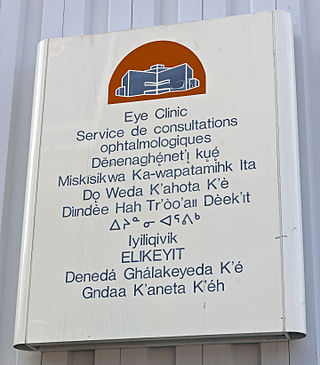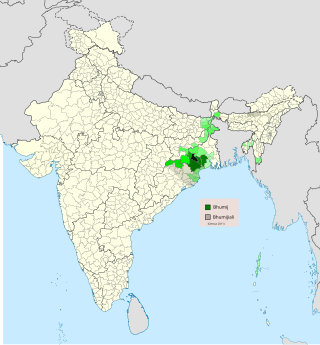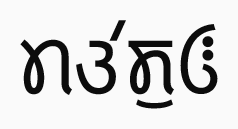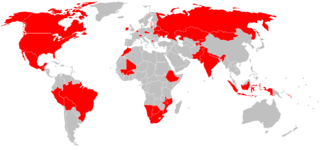Related Research Articles

A first language (L1), native language, native tongue, or mother tongue is the first language a person has been exposed to from birth or within the critical period. In some countries, the term native language or mother tongue refers to the language of one's ethnic group rather than the individual's actual first language. Generally, to state a language as a mother tongue, one must have full native fluency in that language.

Languages spoken in the Republic of India belong to several language families, the major ones being the Indo-Aryan languages spoken by 78.05% of Indians and the Dravidian languages spoken by 19.64% of Indians; both families together are sometimes known as Indic languages. Languages spoken by the remaining 2.31% of the population belong to the Austroasiatic, Sino–Tibetan, Tai–Kadai, and a few other minor language families and isolates. According to the People's Linguistic Survey of India, India has the second highest number of languages (780), after Papua New Guinea (840). Ethnologue lists a lower number of 456.

Of the languages of France, French is the sole official language according to the second article of the French Constitution. French, a Gallo-Romance language, is spoken by nearly the entire population of France.

A multitude of languages have always been spoken in Canada. Prior to Confederation, the territories that would become Canada were home to over 70 distinct languages across 12 or so language families. Today, a majority of those indigenous languages are still spoken; however, most are endangered and only about 0.6% of the Canadian population report an Indigenous language as their mother tongue. Since the establishment of the Canadian state, English and French have been the co-official languages and are, by far, the most-spoken languages in the country.

The Hindi Belt, also known as the Hindi Heartland, is a linguistic region encompassing parts of northern, central, eastern, and western India where various Northern, Central, Eastern and Western Indo-Aryan languages are spoken, which in a broader sense is termed as Hindi languages, with Standard Hindi serving as the lingua franca of the region.

Jharsuguda is a district in Odisha, India with Jharsuguda town as its headquarters. This region is rich in coal and other mineral reserves. Of late, many small and medium scale iron and steel units have been set up in the vicinity of Jharsuguda town, giving impetus to the industrial growth of the district.

Tamang is a term used to collectively refer to a dialect cluster spoken mainly in Nepal, Sikkim, West Bengal (Darjeeling) and North-Eastern India. It comprises Eastern Tamang, Northwestern Tamang, Southwestern Tamang, Eastern Gorkha Tamang, and Western Tamang. Lexical similarity between Eastern Tamang and other Tamang languages varies between 81% and 63%. For comparison, lexical similarity between Spanish and Portuguese, is estimated at 89%.
Canadian Ukrainian is a dialect of the Ukrainian language specific to the Ukrainian Canadian community descended from the first three waves of historical Ukrainian emigration to Western Canada. Canadian Ukrainian was widely spoken from the beginning of Ukrainian settlement in Canada in 1892 until the mid-20th century, when the number of its speakers started gradually declining.

Languages of Nepal, referred to as Nepalese languages in the country's constitution, are the languages having at least an ancient history or origin inside the sovereign territory of Nepal spoken by Nepalis. The 2011 national census listed 123 languages spoken as a mother tongue in Nepal. Most belong to the Indo-Aryan and Sino-Tibetan language families.
Lambadi, Lambani, Lamani or Banjari is a Western Indo-Aryan language spoken by the Banjara people across India. The language does not have a native script.

Romani people in North Macedonia are one of the constitutional peoples of the country.

The Punjabi dialects and languages or Greater Panjabic are a series of dialects and languages spoken around the Punjab region of Pakistan and India with varying degrees of official recognition. They have sometimes been referred to as the Greater Punjabi macrolanguage. Punjabi may also be considered as a pluricentric language with more than one standard variety.
The 2001 census of India was the 14th in a series of censuses held in India every decade since 1871.

The 2011 census of India or the 15th Indian census was conducted in two phases, house listing and population enumeration. The House listing phase began on 1 April 2010 and involved the collection of information about all buildings. Information for National Population Register (NPR) was also collected in the first phase, which will be used to issue a 12-digit unique identification number to all registered Indian residents by Unique Identification Authority of India. The second population enumeration phase was conducted between 9 and 28 February 2011. Census has been conducted in India since 1872 and 2011 marks the first time biometric information was collected. According to the provisional reports released on 31 March 2011, the Indian population increased to 1.21 billion with a decadal growth of 17.70%. Adult literacy rate increased to 74.04% with a decadal growth of 9.21%. The motto of the census was Our Census, Our Future.

Bhumij is an Austroasiatic language belonging to the Munda subfamily, related to Ho, Mundari, and Santali, primarily spoken by Bhumij peoples in the Indian states Jharkhand, Odisha and West Bengal. As per the 2011 census, only 27,506 people out of 9,11,349 Bhumij people spoke Bhumij as their mother tongue, as most Bhumijas have shifted to one of the regional dominant languages. Thus the language is considered an extremely endangered language.
Nyishi is a Sino-Tibetan language of the Tani branch spoken in Papum Pare, Lower Subansiri, Kurung Kumey, Kra Daadi, East Kameng, Pakke Kesang, Kamle districts of Arunachal Pradesh and Darrang District of Assam in India. According to the 2011 census of India, the population of the Nishi speakers is approximately 900,000. Though there are plenty of variations across regions, the dialects of Nishi, such as Akang, Aya, Nyishi (raga), Mishing, Tagin are easily mutually intelligible, with the exception of the rather small in population Bangni-Bangru and Solung Dialects being very different from the former. 'Nisi' is sometimes used as a cover term for western Tani languages.

Mahasu Pahari is a Western Pahari language spoken in Himachal Pradesh. It is also known as Mahasui or Mahasuvi. The speaking population is about 1,000,000 (2001). It is more commonly spoken in the Himachal Pradesh, Shimla (Simla) and Solan districts. It is to be known that Shimla and Solan were parts of the old Mahasu district. Himachal Pradesh State on 1 September, 1972 reorganised the districts dissolving Mahasu district. The Solan district was carved out of Solan and Arki tehsils of the then Mahasu district and tehsils of Kandaghat and Nalagarh of the then Shimla District of Punjab.

Many countries and national censuses currently enumerate or have previously enumerated their populations by languages, native language, home language, level of knowing language or a combination of these characteristics.
The 1991 census of India was the 13th in a series of censuses held in India every decade since 1871.
References
- ↑ Vijayanunni, M. (26–29 August 1998). "Planning for the 2001 Census of India based on the 1991 Census" (PDF). 18th Population Census Conference. Honolulu, Hawaii, US: Association of National Census and Statistics Directors of America, Asia, and the Pacific. Archived (PDF) from the original on 19 November 2008. Retrieved 25 March 2021.
- 1 2 3 4 Mallikarjun, B. (5 August 2002). "Mother Tongues of India According to the 1961 Census". Languages in India. 2. M. S. Thirumalai. ISSN 1930-2940 . Retrieved 11 December 2014.
- ↑ "Census of India 1961 Final Population Totals" (PDF). 1962. pp. 3–6.